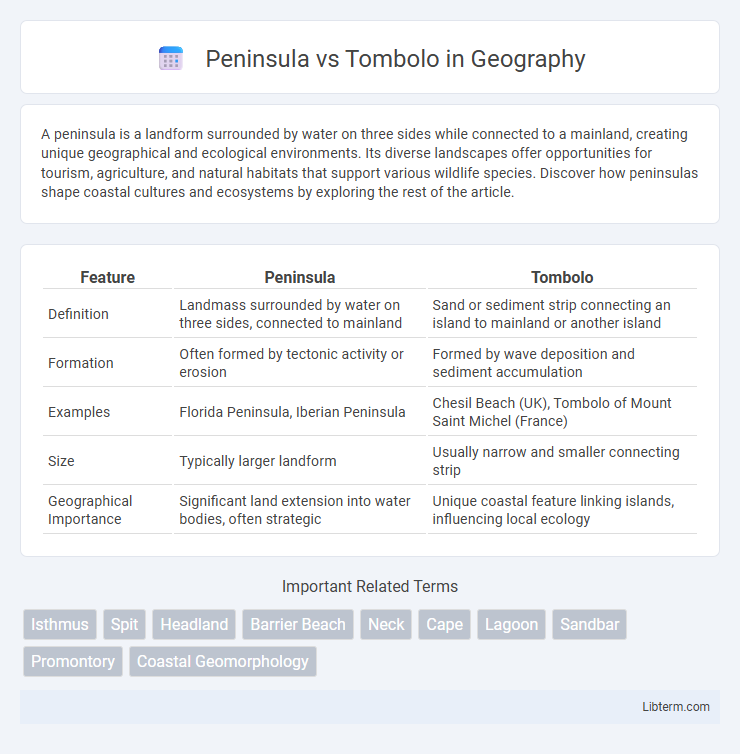A peninsula is a landform surrounded by water on three sides while connected to a mainland, creating unique geographical and ecological environments. Its diverse landscapes offer opportunities for tourism, agriculture, and natural habitats that support various wildlife species. Discover how peninsulas shape coastal cultures and ecosystems by exploring the rest of the article.
Table of Comparison
| Feature | Peninsula | Tombolo |
|---|---|---|
| Definition | Landmass surrounded by water on three sides, connected to mainland | Sand or sediment strip connecting an island to mainland or another island |
| Formation | Often formed by tectonic activity or erosion | Formed by wave deposition and sediment accumulation |
| Examples | Florida Peninsula, Iberian Peninsula | Chesil Beach (UK), Tombolo of Mount Saint Michel (France) |
| Size | Typically larger landform | Usually narrow and smaller connecting strip |
| Geographical Importance | Significant land extension into water bodies, often strategic | Unique coastal feature linking islands, influencing local ecology |
Introduction to Peninsula and Tombolo
A peninsula is a landform surrounded by water on three sides, extending from the mainland into a body of water, prominently influencing coastal geography and ecosystems. A tombolo is a depositional landform where a sand or sediment bar connects an island to the mainland or another island, formed by wave refraction and sediment accumulation. Both features impact local marine navigation and habitat formation, but they differ significantly in origin and structure.
Defining Peninsula: Key Features
A peninsula is a landform surrounded by water on three sides, connected to the mainland by an isthmus, and exhibits a prominent extension of land into a body of water. Key features include its narrow land connection to the mainland, diverse coastal ecosystems, and strategic geographic importance for human settlement and maritime activities. Unlike a tombolo, which is formed by sediment deposition connecting an island to the mainland, a peninsula is naturally contiguous with the main landmass.
Tombolo Explained: Structure and Formation
A tombolo is a coastal landform characterized by a sand or sediment bar that connects an island to the mainland or another island, formed through wave refraction and longshore drift depositing materials in the sheltered area behind the island. This dynamic process creates a narrow strip of land that often shelters a lagoon or bay, influencing local ecosystems and sediment distribution. Unlike a peninsula, which is a large landmass projecting into a body of water, a tombolo specifically results from sedimentary buildup linking landforms together.
Geological Processes Behind Peninsulas
Peninsulas form primarily through tectonic activities, volcanic eruptions, and sediment deposition that extend landmasses into surrounding water bodies, creating distinct coastal features. Erosional forces from waves and currents also shape peninsulas by sculpting softer rock away and leaving resistant rock formations projecting outward. Unlike tombolos, which are formed by sediment accumulation connecting an island to the mainland, peninsulas result from broader geological processes including crustal movements and volcanic island building.
How Tombolos Are Formed
Tombolos are coastal landforms created when sediment accumulates between an island and the mainland, forming a narrow strip of land. Wave refraction around the island causes sediment to deposit in the sheltered area behind it, gradually connecting the two landmasses. This process results in a natural causeway that differs from a peninsula, which is an extension of the mainland surrounded by water on three sides without isolation.
Notable Examples of Peninsulas Worldwide
Notable examples of peninsulas worldwide include the Iberian Peninsula, home to Spain and Portugal, and the Arabian Peninsula, known for Saudi Arabia and its vast desert landscapes. The Florida Peninsula in the United States is a significant landform extending into the Atlantic Ocean and the Gulf of Mexico. In contrast, tombolos, such as Chesil Beach in England and Mount Maunganui in New Zealand, are narrow strips of land connecting an island to the mainland, formed by sediment deposition.
Famous Tombolos Around the Globe
Famous tombolos include Chesil Beach in England, connecting the Isle of Portland to the mainland, and Mont Saint-Michel in France, linking the island abbey to the shore. These unique landforms result from sediment deposition by wave action, creating natural bridges between islands and continents. Unlike peninsulas, which are land extending into water surrounded by three sides, tombolos specifically form due to sand or gravel accumulation that connects an island to the mainland.
Ecological Significance: Peninsula vs Tombolo
A peninsula, extending from the mainland into a body of water, often supports diverse terrestrial and marine ecosystems due to its varied habitats and nutrient flow from land to sea. Tombolos, formed by sediment deposition connecting an island to the mainland, create unique intertidal zones and sheltered waters that serve as critical nurseries for fish and marine invertebrates. Both landforms significantly influence coastal biodiversity and ecosystem services, with peninsulas providing broader habitats and tombolos enhancing coastal connectivity and sediment dynamics.
Comparing Tourism and Economic Impact
Peninsulas, like the Iberian Peninsula, often attract diverse tourism due to their extensive coastlines, varied landscapes, and large urban centers, significantly boosting local economies through hospitality, retail, and maritime industries. Tombolos, such as the famous Chesil Beach in England, draw niche tourism focused on unique geological formations and secluded natural environments, supporting smaller, specialized businesses like eco-tourism and local artisan markets. The economic impact of peninsulas tends to be broader and more robust due to higher visitor volume, whereas tombolos contribute by preserving cultural heritage and promoting sustainable tourism in less developed areas.
Conclusion: Distinguishing Peninsula from Tombolo
A peninsula is a landform surrounded by water on three sides and connected to the mainland, while a tombolo is a sand or sediment bar that links an island to the mainland or another island. The key distinction lies in their formation: peninsulas are primarily natural protrusions of the mainland, whereas tombolos result from sediment deposition by wave action. Understanding these differences aids in accurate geographic classification and coastal management.
Peninsula Infographic

 libterm.com
libterm.com